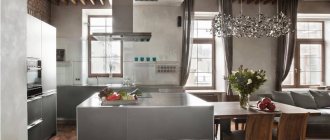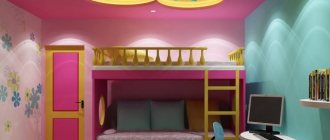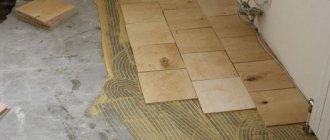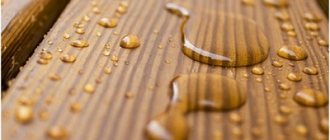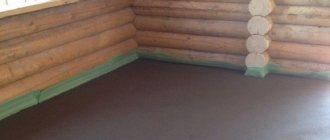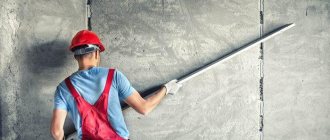The process of constructing a private wooden house consists of several stages, one of which is related to the construction of the floor structure. Its type is chosen at the design stage of the structure and many factors are taken into account. What kind of floors there are in a wooden house, and the features of their designs will be discussed in this article.
Floors in a wooden house
Floor on the first floor - design features
The floor on the ground floor in a wooden house, when there is an unheated basement underneath, has its own characteristics. In this regard, several types of structures can be distinguished:
1. Cold floor construction, installed on an earthen base (without underground). The installation of this type of cold floor is possible only if there is dry soil under the building and a high location of the floors of the lower floor, under which a layer of compacted sand is laid. Another layer of clean, calcined, dry sand is poured on top of it. Logs made of coniferous timber with a thickness of more than 150 mm are buried in the formed soil base and rest against special recesses in the walls of the house. On top there is a single plank flooring, the thickness of which is from 30 to 40 mm.
Wooden floor on the ground
2. Warm floors with a cold underground are recommended in areas where there is a high groundwater level. This design is arranged as follows:
- cleaned sand in a layer of 10 - 15 cm is laid on the ground in the underground and compacted;
- install supports with a height of at least 50 cm. To do this, you can pour concrete mortar into vertically buried pipes with a metal frame of the required height;
- a double layer of waterproofing material and wooden dies 3 cm thick are laid on top of the supports;
- load-bearing beams are laid.
To install thermal insulation, it is necessary to install a subfloor laid on slats nailed to the ends of the joists. For flooring, cut unedged boards are used. Then a layer of vapor barrier and insulation are laid. After this, a plank covering is laid over the beams.
Warm floor with cold underground
3. The installation of a cold floor with a warm subfloor is recommended where the soil has a low level of soil water. In the same way as in the previously described method, the structure is installed, but the stage of installing a subfloor with insulation is skipped and a clean floor is installed.
Plywood
This is a universal building material that combines a wide range of applications and a relatively low price. Plywood is mainly made from softwood or birch.
Advantages of finishing walls and floors with plywood:
- ease;
- strength;
- ease of use and transportation;
- attractive appearance;
- plywood bends easily and does not crack.
Cladding walls in a house, cottage or bathhouse, sheathing trucks, erecting partitions, making furniture, walls, doors, and so on - all this can be done using this lumber.
Plywood can also be laid under floor coverings, or used for packaging, making it into boxes, boxes and other containers.
Plywood is sold not in pieces, but in sheets. You can now buy a sheet of plywood in Moscow and Moscow Region (area 1520 x 1520 mm) at a price of 270 rubles.
What should a wooden house be like?
The floor in a wooden house should be strong, durable, warm and smooth, with an aesthetic appearance.
When performing work on installing a floor in a wooden house independently, they take into account the above requirements, and also determine the procedure for performing the upcoming work, take into account the characteristics of the structure of the building and the individual characteristics of the operation of the house. First, you need to consider the different flooring options that can be installed in a wooden house, study their pros and cons and, taking into account the operating conditions, choose the appropriate option.
Natural wood in the interior of a country house
An important criterion that the floor must meet is its evenness. Regardless of the flooring material, it must meet sanitary, hygienic, structural, operational and aesthetic requirements.
How to paint?
Today, different types of coatings are used to finish a wooden floor and for its durability. When buying a coating, keep in mind that wood has different levels of softness, so you need to choose one that will match the properties of the wood:
- varnish . This product protects wood from mold, mildew, and insects and makes the surface shiny. Varnishes made from polyurethane or organic solvents emphasize the natural shade of the material, and they also dry quickly. Please note that after a few years the wood may become several shades darker. Wood cannot be varnished if it has been treated with drying oil or other substances that contain oil. Also, experts do not recommend varnishing floors in rooms with high humidity;
- painting with oils significantly increases the service life of wood. Using these substances, you can preserve the natural color of the wood or give it any shade. Floors with such a coating cannot be used in rooms with high levels of humidity, as well as with sudden temperature changes;
- wax coating . Its base is wax and linseed oil. Floors with such a coating ideally preserve the natural color and texture of the wood, and the surface becomes silky and has a golden tint. Floors with such a coating do not withstand the influence of abrasive agents.
In addition to transparent coatings, opaque ones are also used. These include colored paints that paint the material a different color and hide its texture. You can choose enamels of different shades - oil, alkyd, pentaphthalic, as well as paints - acrylic and latex. Enamels come in a wide range of colors, and after painting and drying they create a durable film. Thanks to this film, the floor will be resistant to humidity and sudden temperature changes.
To make the right choice, you need to carefully study all the characteristics of the wood and the operating conditions of the floor.
Types of floors
Floors in wooden houses are made of wood or concrete - the most common building materials. The technology of installing a “warm floor system” can also be implemented.
Now there are several types of “warm floors” on the construction market. They differ in the type of coolant and operating efficiency. Which heated floor is better? We'll tell you in our article.
Concrete floor
A popular way to obtain a level base in a relatively short time is to pour a concrete screed. While it may take a month for the screed to dry completely, installing a new wooden one will take longer.
Concrete screed
The advantages of concrete floors are as follows:
- A significant reduction in the cost of the finishing coating device.
- After the screed has dried, a flat base is obtained, but which can be laid with any finishing material.
- With an initially high-quality screed, additional leveling before the final stage of work may not be necessary, which will save time, physical effort and costs of materials.
- The screed can be installed independently, without the involvement of specialists.
You will learn how to install a concrete floor in a private house yourself in two main options - on the ground and on the floors - in our article.
Among the disadvantages, one can note the large weight of the monolithic floor structure and, as a result, an increase in the load on the foundation. Therefore, the necessary foundation calculations are performed at the house design stage. Another nuance is that when the walls vibrate, the screed may crack, which will lead to heat loss. Therefore, when installing a heated floor, it is necessary to perform high-quality thermal insulation of the base.
How to insulate a concrete floor in a private house? Read here.
Installation of the "warm floor" system
Wooden floor
Another common material for flooring in a wooden house is natural wood. Its advantages include the following:
- Environmentally friendly material with a rich natural pattern.
- Wood is safe because it does not contain harmful additives, it is completely natural and does not release harmful toxins into the environment.
- An aesthetic appearance and an organic combination of wood with the rest of the surfaces of the building, while the concrete floor will not look natural.
- When installing a wooden floor, you can refuse other finishing materials. With the help of varnishes, oils, stains and other impregnations, a finished wooden base can become stronger, more durable and acquire an original, noble appearance.
- Wood is very durable and, depending on the species, you can choose a material with certain performance properties and texture.
Wooden flooring can even be used in the hallway
The undeniable quality of natural wood gives an atmosphere of warmth and comfort, creates an optimal microclimate and comfort in the home.
Important! The wooden floor is repairable. To carry out routine repairs of its fragment, it is not necessary to dismantle the entire flooring; a separate fragment can be replaced. This will require a minimum set of tools and construction skills.
Replacing floorboards
Among the disadvantages of a wooden floor, the high cost of the material and the labor involved in its installation are noted. In addition, it can be quite difficult to obtain a perfectly level base.
Useful tips from professionals
Those who are faced with installing a wooden floor for the first time are advised to take into account the advice of professionals, which will greatly facilitate the work:
- Before laying the boards on the joists, they must be tried on, adjusted and numbered.
- To lay a quality floor, you need to choose the right thermal insulation material. The modern market offers a huge selection of technologies for floor insulation, for example, roll or slab materials, bulk and sprayed materials. It is best to use methods that have been proven over the years: clay, wood shavings, sawdust, leaves.
- Professionals do not recommend saving on materials. Choosing a cheap and low-quality coating can lead to further deformation of the surface.
- Don't skimp on flooring technology. If the project requires a layer of insulation, then do not forget about it.
- If you are unable to complete any work yourself, immediately seek help from specialists.
Which is better - concrete or wood?
At the design stage of a private house, you must immediately decide what the floor will be - wooden or concrete. To choose the most suitable option, you need to know what the difference is between these floors.
Price
To fill a screed 5 cm thick, you will need 0.5 bags of cement (300 rubles/bag) and 1.5 (50 rubles/bag) bags of sand. Thus, 1 m2 of screed will cost an average of 225 rubles. If the work will be performed by a hired person, then the cost of the work must be added to this amount - 250 rubles / m2.
Average cost of concrete screed
If we take as a basis dry timber 10 x 10 cm, in increments of 40 cm (400 rubles/m2) and OSB boards (600 rubles/m2) 18 mm thick. With the work of a carpenter, the cost will be 1250 rubles/m2.
Average cost of plank flooring
Communications
In modern houses, the heating, water supply and sewerage systems are laid inside the floor structure. In the event of a pipe break, wooden ones can be quickly sawed and access to communications can be gained. With concrete floors it is more difficult - to remove the screed you will have to use a professional tool, and the process itself will take a lot of time and effort.
Deadlines
The screed gains full strength within 28 days from the date of pouring. Moreover, it gains 70% of its strength in the first week. All this time, the solution gives off moisture and nothing can be laid on it.
Wooden floors can be used immediately after installation.
Filling the screed
Durability
If the installation of a wooden floor is not carried out by a professional craftsman, then after a couple of weeks you can hear a characteristic creaking sound when walking on the floor. Concrete screed does not have this drawback. Moreover, when work is performed by hired workers, the result and quality of their work can be assessed immediately.
Rich texture of natural wood
Weight
The weight of 1 m2 of OSB sheet with a thickness of 18 mm is 12 kg, logs per 1 m2 weigh about 25 kg, depending on the type of wood. Thus, 1 m2 of wooden floor will weigh about 40 kg. And 1m2 of screed with a thickness of 5 cm weighs 100 kg.
OSB
OSB stands for Oriented Strand Board (or OSB - Oriented Strand Board, in English). This is a slab building material made from flat chips (mainly coniferous wood). Developers also often call it “improved wood.”
OSB is widely used today in private housing construction. The advantages of such plates:
- durability;
- resistant to temperature changes;
- not susceptible to rotting and infection by parasites, fungus and insects;
- lightweight;
- the slab is not subject to deformation and retains its elasticity;
- environmental friendliness;
- aesthetics.
OSB boards are sold in sheets (dimensions 2500 x 1250 x 6 mm). The cost of one such sheet in Moscow and Moscow Region costs from 490 rubles.
The process of constructing floors on pillars
When constructing such a floor, the following procedure must be followed:
- Prepare the base. To do this, marking and excavation of soil with a plant layer is carried out. The resulting depression is filled with crushed stone and sand on top, which is then compacted.
- Then the brick support pillars are installed, taking into account the basic design requirements regarding the height of the finished floor and the structure below it.
- It is mandatory to take into account the ratio of the height of the support column and the section of the brick. So, with a support height of 25 cm and above, the recommended width of the support column is equal to two bricks.
- It is necessary to start installing supports first along the perimeter of the future room, and then within the specified boundaries.
- I lay two layers of roofing material on the upper plane of each column to ensure waterproofing of the structure.
- Then the wooden linings are fixed. Logs made of logs or timber are installed on them. The width of the step of their location relative to each other is chosen depending on the width of the floor boards to be laid.
- Slag backfill, the height of which does not reach the log by 5 cm, is used to prevent the mobility of the floor structure in the cold season when the soil freezes. The remaining free space provides ventilation to the structure.
Block pillars
Laying the floor on top of the installed joists is done using boards, which begin to be laid at a distance of 1.5 cm from the wall. The resulting gap performs a ventilation function, which is very important for the correct and long-term operation of a natural wood floor.
The boards are attached to the joists using long nails driven at an angle of 45 degrees. While the wood is not completely dry, install temporary skirting boards.
Floor construction on pillars
Europol
Europol is a covering made from high quality wood, glued across the width. Such wooden floor coverings are very popular in private housing construction and have not lost their relevance for many years.
You can be sure of the durability of this floor. In addition, Europol has the following advantages:
- installation possible without the use of screws and nails;
- a rich range of colors - you will have plenty to choose from to suit your taste and the style of the rest of the decoration;
- suitable for both country houses and apartments;
- resistant to stains;
- Europol will provide a favorable climate and air humidity in the room;
- does not require decorative processing or polishing;
- resistant to fungus and insects;
- Europol is highly resistant to friction and will serve you for many years.
You can now buy Europol in Moscow and Moscow Region at a price starting from 350 rubles per 1 sq. m. m.
Single layer floor
The single floor structure can be placed on poles, as described above. Only on top of the supports are beams placed, on top of which the flooring is made of tongue-and-groove boards.
The second option is to install the floor along beams embedded in the body of the load-bearing enclosing structures of the building. Beams serve as the basis for the floor, and brick supports are no longer required.
Logs for single-layer flooring
Due to the large free distance between the beams, the fastening of the flooring from the boards is carried out along the sheathing:
- The sheathing is made of timber with a square section of 5-6 cm.
- The pitch of the timber in the sheathing depends on the thickness of the floor board. The thinner the board, the smaller the distance between the lags.
- During the installation of the sheathing, it is important to control its horizontal position so that the end result is an even plank covering.
- Fastening the boards begins after all the logs are installed in their places and securely fixed with nails.
- If it is not planned to lay additional decorative covering on top of the flooring - laminate, tile, linoleum, then it is finished.
- After the single decking is installed, it is covered with two layers of protective varnish.
Instructions for attaching plank flooring
Advice. If the flooring is rough, then you can use an unedged board to construct it.
When making a single floor, no serious professional skills or significant time and financial costs are required. But its disadvantage is its low thermal insulation properties.
Profiled timber
In recent years, this has been a very popular lumber in private housing construction. Houses and bathhouses made of profiled timber look very beautiful, and at the same time have a number of other advantages:
- optimal price-quality ratio;
- the design prevents the ingress of water and moisture;
- minimal costs for insulation;
- pleasant appearance allows you to save on interior decoration;
- Being a natural building material, profiled timber provides optimal humidity in the premises.
You can now buy profiled timber in Moscow and Moscow Region at a price starting from 7,500 rubles per 1 cubic meter. m.
Double floor design
The optimal solution for arranging the floor in a wooden house is a two-layer structure, consisting of a rough and finishing layer. Installation of such a structure occurs in the following way:
- The subfloor is installed from unedged boards up to 4.5 cm thick, treated with an antiseptic compound. In this case, preference should be given to coniferous wood - it is durable, resistant to moisture, dampness and decay.
- The boards are laid close to each other, and a layer of thermal insulation made of mineral wool, polystyrene foam, expanded clay or sawdust is laid on top.
- In addition to insulation, it is necessary to steam and waterproof the structure to extend its service life.
- The finished floor boards are laid as for other types of structures, leaving a gap of 1.5 cm between them with the subfloor.
A clean floor can serve as a finishing coating or serve as a basis for laying decorative flooring, which will not only decorate the room, but also increase the thermal insulation properties of the floor.
Double floor design
Planed board
This is an ideal choice for cladding facades and interior decoration, production of furniture, parquet and other interior elements. It is made from coniferous and deciduous wood.
Due to special processing, planed boards are smoother and drier, which allows them to extend their service life (compared to conventional boards).
Please note: if you want to decorate a bathhouse or sauna with planed boards, it is better to choose lumber from deciduous wood, since coniferous boards have a high resin content.
You can now buy planed boards in Moscow and Moscow Region at prices starting from 9,000 rubles per 1 cubic meter. m.
Start of work - installation of the subfloor
A subfloor when installing plank flooring is necessary for several reasons:
- To increase the operational life of the structure due to the presence of high-quality floor ventilation.
- It serves as a solid base for laying insulation and finishing flooring.
- Makes the frame of the building more rigid.
Before starting work on the installation of the rough structure, check the following:
- The wood chosen as the material for the construction of the subfloor must have an optimal level of humidity - this will eliminate possible deformation of the structure during its subsequent use.
- The boards should not have obvious defects.
- If an inexpensive board can be used for the subfloor, then for the finished floor it is purchased with a reserve, so that later you do not have to look for material of the same shade.
Double floor
Preparation
Installation of the subfloor can be carried out both on the ground and on the floors. In any case, it is necessary to carry out a set of preparatory measures:
- The walls of the building must be equipped with ventilation windows, closed from the outside with special grilles.
- All wooden parts are treated with antiseptic compounds to increase the service life of the structure.
- Taking into account the size of the room in which the floor will be installed, calculate the required amount of material.
- Throughout all work, it is important to monitor the horizontal position of the floor structure to prevent the formation of a slope.
- Timber and logs are subject to processing, in which they are cut to eliminate slopes and bevels.
Treating boards with an antiseptic
Laying the subfloor
To ensure that the floor does not creak, does not vibrate, is smooth and warm, it is necessary to pay special attention to the laying of the subfloor and, first of all, to the joists.
Attaching the log
The logs should be suspended on the beam supports in increments of 60 cm - insulation will be laid in the gap formed. It is not worth saving on beams in order to avoid sagging and vibration of the floor during operation.
The step can be reduced if the load on the coating is to increase
Where heavy equipment, such as a stove or fireplace, will subsequently be installed, the floor is reinforced by placing beams in 30 cm increments.
Additional lag fixation
Fastenings in such places are also further reinforced.
The process of attaching slats
At the bottom, beams are nailed across the beams. Between floors, beams are nailed along the beams - this will save the height of the room and, if necessary, use the upper beams as a decorative element in the interior after their additional finishing.
Fastening bars along beams
In the gap, an OSB sheet is laid on the beams.
Laying OSB sheet
After this, mineral wool slabs are laid in a checkerboard pattern, and on top there is a continuous layer of vapor barrier, which covers the logs and is fixed with a construction stapler. The vapor barrier seam is taped.
Laying vapor barrier
The second layer of vapor barrier is laid overlapping, and a ventilation gap is formed on top. To do this, use a 40 x 100 mm block, screwed to the floor joists. The finishing floor will be installed on top of these bars.
Bar for organizing ventilation
Important! All wooden elements must be treated with antiseptic compounds.
Video - Insulating a wooden floor
Block house
This is a wall covering, which is essentially an imitation of a rounded log, and differs from it in some advantages: the surface of the block house is perfectly flat and resistant to cracks.
The block house is made from high-hard wood that is resistant to rot and moisture. It is excellent for finishing rooms outside and inside, and is also used in finishing ceilings, balconies, and gables.
This lumber will serve you not only when decorating your house - you can use it to make an excellent (and, importantly, high-quality) fence.
You can now buy a block house in Moscow and Moscow Region at a price starting from 340 rubles per 1 sq. m. m.
Finished floor installation
To obtain an aesthetically attractive and durable finished floor, it is recommended to use a milled board with a tongue-and-groove fastening.
tongue and groove board
Table 1. Instructions for laying finished floorboards
| Illustration | Description |
| The first board is laid with a groove against the wall, leaving an expansion gap. | |
| It must be secured with self-tapping screws so that you can later cover the attachment point with a plinth. There are 2 options for further fastening the boards. | |
| The first option uses self-tapping screws that are twice as long as the floorboard. | |
| Self-tapping screws are screwed into each joist in the center of the board. Subsequently, the caps can be masked using wood putty. | |
| Then take the next board and align the tenon with the groove. | |
| If necessary, the boards are adjusted by hitting them with a mallet through a block. | |
| Or they press it with a chisel. | |
| The second fastening option involves screwing self-tapping screws at an angle of 45 degrees into the tenon. To prevent the board from bursting, you must first drill a hole for the screw. | |
| With this option, the boards fit closer to each other, and the fastening elements are invisible. |
After all the boards are laid, their surface is sanded and coated with wear-resistant varnish in several layers.
Imitation of timber
Imitation timber is one of the types of lining, also made from natural wood, and looks like natural timber. This lumber is also very popular in house construction, because in appearance the imitation from real timber is practically indistinguishable.
Imitation timber is highly durable, moisture resistant, and not susceptible to mold and rot. Used for interior and exterior decoration of houses. In general, an excellent option for budget wood trim - saving money without losing style!
You can now buy imitation timber in Moscow and Moscow Region at a price starting from 300 rubles per 1 sq. m. m.
Concrete floor in a wooden house
The most common way to install a concrete floor in a wooden house is to pour it over the ground, but with the obligatory condition that the ground must be dry.
Construction of a concrete floor on the ground
Stage 1 – preparation
Preparatory work includes the following steps:
- Using a level, determine the main indicators and calculate the excavation work.
- To prevent soil subsidence and cracking of the concrete floor in the future, the soil is carefully compacted using special devices.
- A well-compacted sand cushion is placed over the ground. The backfill will be denser if you pour material that exceeds the required volume by 25%, moisten it and compact it thoroughly using a roller or vibrator.
- An expanded clay or gravel layer is laid on the sand.
Petrol single-pass vibrating plate Masalta MS 125-4
Stage 2 - waterproofing
At the next stage , it is necessary to waterproof the base so that it does not absorb moisture from the concrete screed, and it will also protect the floor from ground moisture. For this purpose, roll materials based on bitumen are used. You can use thick plastic film.
The waterproofing material is laid overlapping, extending it onto the wall by 20 cm, and then the joints are taped. It is important that the material is homogeneous and without damage.
An alternative method is the coating method, when mastic waterproofing is applied at the stage of pouring the subfloor.
Dense polyethylene as a waterproofing layer
Stage 3 - pouring the subfloor
The subfloor or technological floor serves as the basis for the hydro- and vapor barrier layer. For its production, concrete of class B7.5 - B10 and crushed stone of size 50-20 are used. There are no strict rules for pouring the rough layer, the main thing is that its thickness is about 50 mm, and the difference does not exceed 4 mm.
Stage 4 – vapor barrier and insulation
A vapor barrier material in the form of inexpensive membranes made of fiberglass or polyester is laid on top of the subfloor. PVC membranes are a durable material that is not afraid of rotting. Insulation is laid over the vapor barrier - this can increase the energy efficiency of a living space by 20%. The following materials can be used as insulation:
- Mineral wool, the density of which does not exceed 120 kg/m3. To prevent it from accumulating cotton wool, it is insulated with polyethylene.
- Where the floor is subject to heavy loads, it is recommended to use extruded polystyrene foam, which deforms when compressed and then returns to its original state.
- When using polystyrene foam, it is covered with polyethylene on all sides to give strength.
Types of insulation
Stage 5 – final screed
At the final stage, the final screed is performed, which will become the basis for the decorative flooring. It can be monolithic or dry. In the first case, pouring a solution with a coarse filler in the form of crushed stone, stones, small pebbles or a cement-sand composition (quartz sand) is carried out along the beacons. Begin pouring the screed from the far corner of the room, leveling the solution using the rule. Complete drying of the screed occurs after 30 days.
Monolithic screed
An alternative is a dry screed based on fiberboard, plywood and asbestos-cement sheets, gypsum boards. The technology is simple and fast:
- Line with plastic film.
- A technological gap of 1 cm is left along the walls, into which soundproofing material is placed.
- Sand backfill is 5 cm thick.
- The sheet material is laid in two layers and securely fixed to each other using self-tapping screws or construction adhesive.
- Perform puttying and sanding of joints.
Dry screed
Finishing materials
The material for finishing the floor in a wooden house is selected depending on the interior design. If the appearance of the house inside retains the color of natural wood, which on the walls and ceiling is not hidden behind other finishing, then the flooring should be organically combined with it.
Table 2. Types of flooring
| Illustration | Description |
Boards – larch, cedar, pine | In a wooden house, the best solution would be to install a floor made of natural wood. It will organically fit into the interior with wooden wall paneling. Wood has low thermal conductivity, it is environmentally friendly and safe. Natural wood flooring is distinguished by a variety of textures and rich natural patterns. |
Parquet | A beautiful and natural floor covering for a wooden house can be obtained by laying parquet made of natural wood, which has high aesthetics, a variety of shades and good performance. |
Ceramics in wet areas | In rooms with high humidity - bathroom, shower bath, kitchen, as well as in the hallway, laying tiles will be a practical solution. |
Laminate | An alternative material to expensive natural wood is laminate, which is highly durable, wear-resistant and decorative. This material imitates many, even rare and very expensive types of wood. |
Planed timber
This type of timber is considered a universal lumber, since it can be used as a raw material for the production of other wood materials based on it.
Planed timber is excellent for construction and repair, interior decoration, as well as for making furniture. And, thanks to its affordable price, it is one of the most popular and sought-after lumber among private developers.
Its advantages:
- ensuring good sound insulation;
- allows you to retain heat inside the house;
- environmentally friendly - does not contain harmful impurities, therefore safe for internal use;
- resistant to deformation;
- mildew resistant;
- it will serve you for many years.
You can now buy planed timber in Moscow and Moscow Region at a price starting from 10,500 rubles per 1 cubic meter. m.





